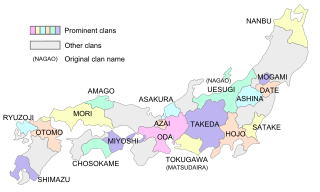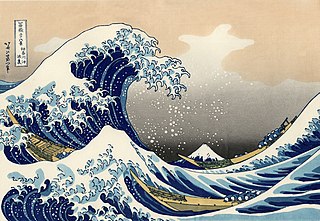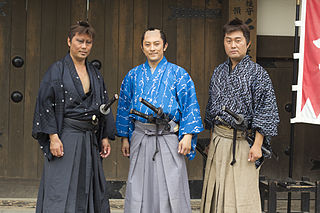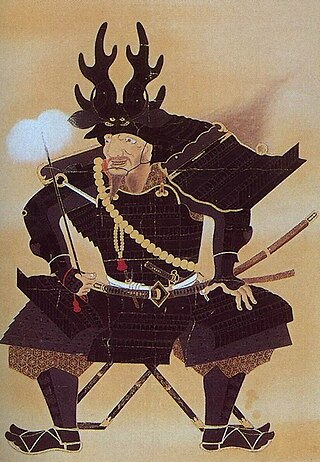Related Research Articles

Samurai were the hereditary military nobility and officer caste of medieval and early-modern Japan from the late 12th century until their abolition in the late 1870s during the Meiji era. They were the well-paid retainers of the daimyo, the great feudal landholders. They had high prestige and special privileges.

Shogun, officially sei-i taishōgun, was the title of the military rulers of Japan during most of the period spanning from 1185 to 1868. Nominally appointed by the Emperor, shoguns were usually the de facto rulers of the country, except during part of the Kamakura period and Sengoku period when the shoguns themselves were figureheads, with real power in the hands of the shikken (執権) of the Hōjō clan and kanrei (管領) of the Hosokawa clan. In addition, Taira no Kiyomori and Toyotomi Hideyoshi were leaders of the warrior class who did not hold the position of shogun, the highest office of the warrior class, yet gained the positions of daijō-daijin and kampaku, the highest offices of the aristocratic class. As such, they ran their governments as its de facto rulers.

The Tokugawa shogunate, also known as the Edo shogunate, was the military government of Japan during the Edo period from 1603 to 1868.

Daimyo were powerful Japanese magnates, feudal lords who, from the 10th century to the early Meiji period in the middle 19th century, ruled most of Japan from their vast hereditary land holdings. They were subordinate to the shogun and nominally to the emperor and the kuge. In the term, dai (大) means 'large', and myō stands for myōden (名田), meaning 'private land'.

In feudal Japan (1185–1868), a rōnin was a samurai who had no lord or master and in some cases, had also severed all links with his family or clan. A samurai becomes a rōnin upon the death of his master, or after the loss of his master's favor or legal privilege.

The Edo period, also known as the Tokugawa period, is the period between 1603 and 1868 in the history of Japan, when Japan was under the rule of the Tokugawa shogunate and the country's 300 regional daimyo. Emerging from the chaos of the Sengoku period, the Edo period was characterized by economic growth, strict social order, isolationist foreign policies, a stable population, overall peace, and popular enjoyment of arts and culture, colloquially referred to as Ōedo.

The Muromachi period or Muromachi era, also known as the Ashikaga period or Ashikaga era, is a division of Japanese history running from approximately 1336 to 1573. The period marks the governance of the Muromachi or Ashikaga shogunate, which was officially established in 1338 by the first Muromachi shōgun, Ashikaga Takauji, two years after the brief Kenmu Restoration (1333–1336) of imperial rule was brought to a close. The period ended in 1573 when the 15th and last shogun of this line, Ashikaga Yoshiaki, was driven out of the capital in Kyoto by Oda Nobunaga.

The Azuchi–Momoyama period was the final phase of the Sengoku period in Japanese history from 1568 to 1600.
Han is a Japanese historical term for the estate of a daimyo in the Edo period (1603–1868) and early Meiji period (1868–1912). Han or Bakufu-han served as a system of de facto administrative divisions of Japan alongside the de jure provinces until they were abolished in the 1870s.
The koku (斛) is a Chinese-based Japanese unit of volume. 1 koku is equivalent to 10 to or approximately 180 litres, or about 150 kilograms (330 lb) of rice. It converts, in turn, to 100 shō and 1000 gō. One gō is the traditional volume of a single serving of rice, used to this day for the plastic measuring cup that is supplied with commercial Japanese rice cookers.

Sankin-kōtai was a policy of the Tokugawa shogunate during most of the Edo period, created to control the daimyo, the feudal lords of Japan, politically, and to keep them from attempting to overthrow the regime. It required most daimyo to alternate between living in their domain and in the shogunate's capital, Edo, every year. This made the daimyo subject to constant surveillance from the shogunate. This also forced the daimyo to have residences in both their domain and Edo. The cost of maintaining several lavish residences as well as the journeys to and from Edo was a constant drain on the finances of the daimyo, which greatly increased the shogunate's control over them and kept them militarily weak. The daimyo were also required to keep their wife and children in Edo permanently to act as hostages.

Jidaigeki is a genre of film, television, video game, and theatre in Japan. Literally meaning "period dramas", it refers to stories that take place before the Meiji Restoration of 1868.

Fudai daimyō (譜代大名) was a class of daimyō (大名) in the Tokugawa Shogunate (徳川幕府) of Japan who were hereditary vassals of the Tokugawa before the Battle of Sekigahara. Fudai daimyō and their descendants filled the ranks of the Tokugawa administration in opposition to the tozama daimyō and held most of the power in Japan during the Edo period.

This is the glossary of Japanese history including the major terms, titles and events the casual reader might find useful in understanding articles on the subject.

Rice brokers, which rose to power and significance in Osaka and Edo in the Edo period (1603-1867) of Japanese history, were the forerunners to Japan's banking system. The concept originally arose in Kyoto several hundred years earlier; the early rice brokers of Kyoto, however, operated somewhat differently, and were ultimately not nearly as powerful or economically influential as the later Osaka system would be.

The Dōjima Rice Exchange, located in Osaka, was the center of Japan's system of rice brokers, which developed independently and privately in the Edo period and would be seen as the forerunners to a modern banking system. It was first established in 1697, officially sanctioned, sponsored and organized by the shogunate in 1773, reorganized in 1868, and dissolved entirely in 1939, being absorbed into the Government Rice Agency (日本米穀株式会社)(cf.ja:食糧管理制度).
The Buke shohatto, commonly known in English as the Laws for the Military Houses, was a collection of edicts issued by Japan's Tokugawa shogunate governing the responsibilities and activities of daimyō and the rest of the samurai warrior aristocracy. These formed the basis of the bakuhan taisei which lay at the foundation of the Tokugawa regime. The contents of the edicts were seen as a code of conduct, a description of proper honorable daimyō behavior, and not solely laws which had to be obeyed. By appealing to notions of morality and honor, therefore, the shogunate was able to see its strictures followed despite its inability to enforce them directly.
Komono Domain was a feudal domain under the Tokugawa shogunate of Edo period Japan, located in Ise Province in what is part of now modern-day town of Komono, Mie. It was centered around Komono jin'ya. Komono Domain was controlled by the tozama Hijikata clan throughout its history. Hijikata Toshizō, the famed leader of the pro-Tokugawa Shinsengumi during the Bakumatsu period was from a distance cadet branch of the Hijikata clan, and has no connection with this domain.

Edo society refers to the society of Japan under the rule of the Tokugawa Shogunate during the Edo period from 1603 to 1868.
Kashindan (家臣団) was an institution of the retainers (kashin) of the shogun or a daimyo in Japan that became a class of samurai. It was divided into the military commanders (bankata) and the civil officers (yakukata).
References
- ↑ "Feudalism in Medieval Japan". World History Encyclopedia . Retrieved 2019-11-04.
- ↑ Szczepanski, Kallie. "How Japanese Feudalism Differed From Europe's Feudal System". ThoughtCo. Retrieved 2019-11-05.
- ↑ "Food & Agriculture in Ancient Japan". World History Encyclopedia . Retrieved 2019-11-05.
- ↑ Pearson, Richard (10 March 2016). "Japanese medieval trading towns: Sakai and Tosaminato" (PDF). Japanese Journal of Archaeology.
- ↑ {{Cite boondocks k|title=The Origins of Japan's Medieval World|last=Mass|first=Jeffrey|publisher=Stanford University Press|year=1997|location=Stanford, California|pages=99–100}}
- ↑ Family and population in East Asian history. Hanley, Susan B., 1939-, Wolf, Arthur P., Joint Committee on Chinese Studies (U.S.), Joint Committee on Japanese Studies. Stanford, Calif.: Stanford University Press. 1985. ISBN 0804712328. OCLC 11210819.
{{cite book}}: CS1 maint: others (link) - ↑ Listen, copy, read : popular learning in early modern Japan. Hayek, Matthias, Horiuchi, Annick. Leiden. 2014-09-12. ISBN 9789004279728. OCLC 893333538.
{{cite book}}: CS1 maint: location missing publisher (link) CS1 maint: others (link) - ↑ Curtin, Philip D. (2000). The world and the West : the European challenge and the overseas response in the Age of Empire. Cambridge, UK: Cambridge University Press. ISBN 0521771358. OCLC 42290254.
- ↑ Vaporis, Constantine Nomikos, 1957- (2019-03-14). Samurai: an encyclopedia of Japan's cultured warriors. Santa Barbara, California. ISBN 9781440842719. OCLC 1054262009.
{{cite book}}: CS1 maint: location missing publisher (link) CS1 maint: multiple names: authors list (link) CS1 maint: numeric names: authors list (link) - ↑ Shiels, Rebecca. "LibGuides: Medieval Japan 'Power and Perspective': Social Structures". libguides.msben.nsw.edu.au. Retrieved 2019-11-05.
- ↑ Moss, David A.; Kintgen, Eugene (2009-01-30). "The Dojima Rice Market and the Origins of Futures Trading".
{{cite journal}}: Cite journal requires|journal=(help) - ↑ Boxer, Charles Ralph (1951). The Christian Century in Japan: 1549-1650. University of California Press. pp. 91–92.
- ↑ Honda, Hiroyuki (2007). "Copper Coinage, Ruling Power, and Local Society in Medieval Japan". International Journal of Asian Studies. 4 (2): 225–240. doi:10.1017/S1479591407000745. S2CID 144293579.